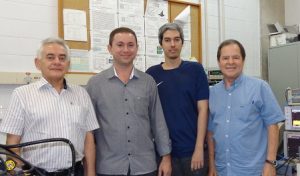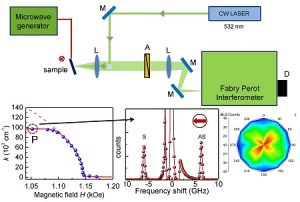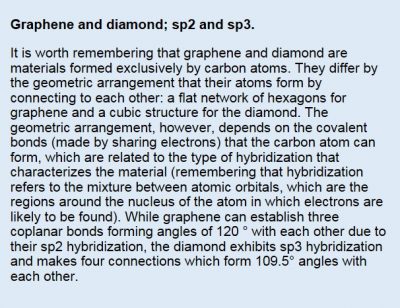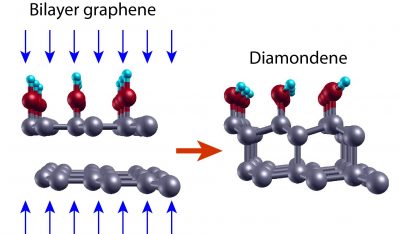
A Brazilian scientific team announced in Nature Physics (impact factor 22,806), a remarkable novelty about the atomic and subatomic dimension of nature, object of Quantum Physics, in which tiny particles that also behave like waves move around without stopping.
The team, led by Professor Sergio Machado Rezende, was able to experimentally detect, for the first time in science history, phonons with spin – something like a collective vibration of interconnected atoms (phonon) spinning around an axis (spin). “Never had anybody observed a phonon with spin before these experiments,” contextualizes Prof. Rezende (Federal University of Pernambuco, UFPE).
The research was entirely carried out in the Department of Physics of UFPE, with funding from Brazilian research support agencies (CNPq, CAPES and FINEP and FACEPE).
The spin is a property of subatomic particles, and it is the origin of magnetic properties in materials. In a first approach to the concept, it can be represented as a rotational movement of the particle.
The discovery could have an important effect on the so-called “spintronics,” both from a fundamental (understanding of phenomena) and applied point of view. Just as electronics uses the electric charge of electrons to develop technology, the still incipient spintronics takes advantage of spin to encode and store data, transport, and decode them. That is why the evidence presented in the article of Nature Physics opens possibilities of employing phonons in the development of spintronic devices.
The research was developed within the PhD thesis of José Holanda da Silva Júnior, defended on April 20 of this year at UFPE, and guided by Professor Sergio Rezende (known for having held the position of Minister of Science and Technology in Brazil from 2005 to 2010).
The idea of the thesis work was to generate a spin wave (a collective excitement of spins) into a ferromagnetic material and convert it into an elastic wave (a collective vibration of a network of atoms). In quantum terms, the goal was to convert “magnons” into “phonons” – a transformation that can be achieved since in ferromagnetic materials the motion of spins can cause vibrations in the network of atoms.
The idea of the magnon-phonon conversion was well studied in the 1960s and 1970s, Rezende comments. However, at that time it was not possible to obtain clear experimental evidence of the conversion, since the materials available to make the experiments limited the observation of the effect. “Cylinders of ferromagnetic materials were used,” says Rezende. “The effect occurred, but it was inside the material and there was no way to test if it was actually occurring,” he adds. To obtain definitive evidence, it was necessary to use very thin layers of ferromagnetic material.
In the last 20 years, explains Rezende, technology has been developed to make thin films of various materials. As a result, the academic interest in magnon-phonon conversion has returned, generating numerous advances in the understanding of the phenomenon in the last decade.
In this new context, José Holanda, his advisor Prof. Rezende and collaborator Prof. Antônio Azevedo da Costa were able to manufacture a thin film of the most suitable ferromagnetic material to study the magnon-phonon conversion, the yttrium and iron grenade. With this thin film, the team prepared samples in the form of tapes of 2 x 12 square millimeters of surface and 8 micrometers of thickness, and used them to perform two types of major experiments.
The first consists, in broad lines, of applying microwave radiation to one of the two ends of the film, generating spin excitations in the material. Consequently, the spin is oriented around the magnetic field that is applied (phenomenon known as “precession”). This collective precession starts at one end of the sample and propagates as a real “spin wave” until it reaches the other end.
If the magnetic field applied to the sample is uniform, the spin wave attenuates itself and does not become an elastic wave. Therefore, the Pernambuco team used rare earth magnets (one at each end of the sample) to cause variations in the magnetic field along the film, following the spin wave displacement.

The experiments with microwaves generated evidence that the magnon-phonon conversion was taking place, but the group considered it important to confirm, or not, the results through measurements of the so-called Brillouin scattering. In this experiment, laser light is applied at some point in the sample and the scattered light is analyzed. The result allows determining the nature of the excitation (in this case, magnon or phonon) that is interacting with light. “The great advantage of using a film instead of a massive material is that you can focus the laser at any position in the film and can vary the angle of incidence,” explains Rezende.
Through Brioullin scattering, the team not only could verify that the spin wave (magnon) subjected to a non-uniform magnetic field had actually converted into an elastic wave (phonons), but also they came upon a surprise: these phonons spread circularly polarized light. – evidence that they had spin. “We did not expect that the phonon produced by the conversion of the magnon also had a certain rotation motion, which is what we call spin,” says Rezende.
After making this discovery experimentally, the team made the corresponding theoretical calculations. “We confirmed that the theory actually predicted that the phonon had spin, but we did not know the theory before,” Professor Rezende reveals.
[Paper: Detecting the phonon spin in magnon–phonon conversion experiments. J. Holanda, D. S. Maior, A. Azevedo & S. M. Rezende. Nature Physics (2018) doi:10.1038/s41567-018-0079.]




